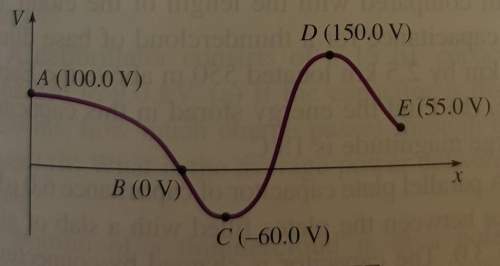
Physics, 26.07.2019 22:30 AshlynPlayz45
The figure shows a graph of electric potential versus position along the x-axis. a proton is originally at point a, moving along in the positive x direction. how much kinetic energy does it need to have at point a in order to be able to reach point e (with no forces acting on the proton other than those due to the indicated potential)? points b, c and d have to be passed on the way.


Answers: 1


Other questions on the subject: Physics

Physics, 21.06.2019 16:40, 25mnauman
An airplane flying parallel to the ground undergoes two consecutive displacements. the first is 76 km at 39.8◦ west of north, and the second is 156 km at 59.9◦ east of north. what is the magnitude of the plane’s total displacement? answer in units of km. 020 (part 2 of 2) 10.0
Answers: 1

Physics, 21.06.2019 19:30, noberoger2780
Asun-sized star will spend most of its lifetime as a: white dwarf red giant protostar main-sequence star
Answers: 1

Physics, 22.06.2019 05:30, yiikes4012
Will give brainliest! which statement best describes the difference between strong nuclear forces and weak nuclear forces? weak nuclear forces are involved when certain types of atoms break down. strong nuclear forces are responsible for holding atoms' nucleus together. weak nuclear forces hold bonds between atoms together. strong nuclear forces hold together the nucleus of an atom. strong nuclear bonds prevent atoms from falling apart. weak nuclear bonds prevent compounds from falling apart. strong nuclear forces are involved in breaking electrons from their shells. weak nuclear forces hold protons in the nucleus.
Answers: 3

Physics, 22.06.2019 19:30, beth999
Select light for the type of wave, adjust the wavelength so that the light is red, and increase the amplitude of the light to the max. then, select the start button at the source location to begin producing the waves. light is a form of electromagnetic wave, containing oscillating electric and magnetic fields. the wave amplitude detector mentioned above shows how the electric field oscillates in time at the location of the probe. the amplitude of the wave at the location of the probe is equal to the maximum electric field measured. how does the amplitude of the wave depend on the distance from the source?
Answers: 2
You know the right answer?
The figure shows a graph of electric potential versus position along the x-axis. a proton is origina...
Questions in other subjects:


Mathematics, 05.07.2019 23:30


English, 05.07.2019 23:30

Mathematics, 05.07.2019 23:30


History, 05.07.2019 23:30

History, 05.07.2019 23:30


Mathematics, 05.07.2019 23:30



